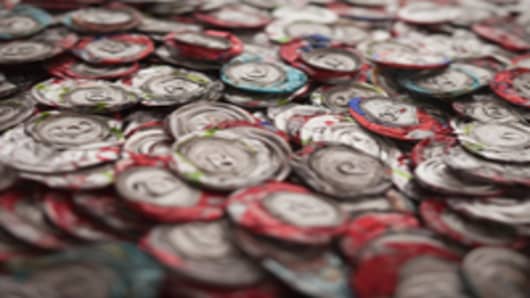Even if the pre-recession days of "conspicuous consumption" are over, Americans still generate an incredible amount of trash through their purchases of food, household products, and other goods.
A report by the Environmental Protection Agency describes the contents of all the garbage produced in a single year.
According to the 2008 report, approximately 250 million tons of municipal solid waste is created, which excludes hazardous waste, industrial waste, and construction waste.
With so much garbage piling into Hefty bags, trash cans, Dumpsters, refuse trucks, recycling facilities, and landfills every year, it’s worth asking: What is all this stuff that we’re throwing out?
The EPA report estimates that individuals and households generate as much as 65 percent of all municipal solid waste. While large households undoubtedly contribute significantly to this amount, every type of home is responsible for some portion of it.
Even a small studio apartment occupied by only one parent and a baby generates more garbage than you might think, since the average baby goes through 8,000 to 10,000 diapers before successfully potty training. That adds up to approximately 18 billion Huggies, Luvs and Pampers thrown away each year, or 100,000 tons of plastic and 800,00 tons of tree pulp, according to the Clean Air Council.
Diapers, like all single-use items with a short lifespan, fall into the category of nondurable goods. So do disinfectant wipes, batteries and any other product that is repeatedly restocked by parents with small children.
Altogether, Americans generate 59 million tons of nondurable goods each year. However, this is not the most common type of municipal solid waste in the United States—the containers that hold them are. Formula, rice cereal and bottle liners are all sold in paper boxes and sealed in shrink wrap, all of which contributes to the 77 million tons of discarded packaging delivered to landfills each year.
The remaining 35- 45 percent of the garbage in the municipal solid waste stream comes from businesses and institutions such as hospitals and schools.
It’s easy to see how an office building in Manhattan’s financial district or a busy hospital in Chicago could make major contributions to the waste stream, but even small institutions in undersized states play a significant role.
For example, the average public school in the tiny state of Delaware has 185 students, well below the national average. Assuming that each of those students eats one cafeteria meal a day for 200 school days, you can understand how all the partially consumed hamburger buns and spaghetti strands can turn into an impressive heap of waste in not much time.
The good news about all of this garbage is that the rate of waste recovery in the United States has increased quite a bit in recent years. In 2008, one third of the United States’ 250 million tons of municipal solid waste were composted or recycled, accounting for a full 83 million tons. This includes over 55 percent of the 78 million tons of paper products that was recycled, according to the EPA.
The rate of waste recovery in the United States suggests that Americans may become more receptive to municipal recycling and composting programs in the future. In Toronto, Canada, a municipal effort known as the Green Bin Program collects the organic waste of over half a million households, to great success.
It’s entirely possible to imagine that similar composting efforts may come to the United States in some not too distant tomorrow. When it comes to becoming more aware of the need to reduce waste, Americans appear to have gotten the memo.
- Quiz: Test Your Knowledge of E-Cycling
- Interactive 50-State Map: Trash Across America
On Wednesday, September 29 at 9pm ET/PT, CNBC presents “Trash Inc: The Secret Life of Garbage,”a CNBC Original reported by Carl Quintanilla that takes an inside look at what happens to our garbage after we throw it out – where it goes, who touches it, and who makes money.



